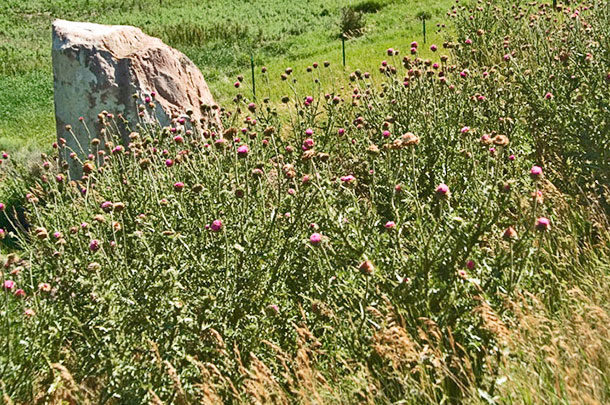I hate to spoil this pleasant scenario, but it also has been a great fall for winter annual weeds to get started. Winter annuals like pennycress and mustards, cheatgrass and downy brome, henbit and musk thistle. Check your fields now, and you might find lots of small henbit plants or mustard rosettes or short annual grass seedlings.
This robust start suggests potentially heavy weed growth next spring. If left uncontrolled in alfalfa fields, they could grow rapidly, reducing yield, thinning stands and lowering forage quality.
To avoid next spring’s weed infestation, spray fields with the appropriate herbicides this fall before soils freeze up. There are more than half a dozen herbicides that can do an excellent job of controlling winter annual weeds when used correctly. Some may work better on specific weeds than others, so determine what weeds cause your most serious problems and select herbicides accordingly.
Now you might be thinking, “I can wait until early next spring to spend money on these herbicides to spray for these weeds.” And you’re right – you can wait. The risk with this thinking, though, is that spring spraying must be done before alfalfa greens up or you will injure your alfalfa plants. Usually, there are only a few days in spring where alfalfa is dormant, the weeds are actively growing and it’s not too wet or windy. Many times, fields don’t get sprayed at all, or they get sprayed late and alfalfa suffers some setback.
Reduce your risk of missing that spring spraying window by taking advantage of opportunities this fall to control next spring’s weeds.

Pastures often have similar challenges. Winter annual bromes such as cheatgrass and downy brome often invade thin or overgrazed pastures in fall and early spring. Livestock dislike grazing them, so over time they can take over and make large patches of pasture nearly worthless.
Usually the most effective control method is to spray Plateau (imazapic) herbicide as a pre-emerge treatment to prevent most annual bromes from developing. However, it is likely that for most of us, some (or maybe a lot) of these grass seedlings have already emerged. When this situation exists, add an adjuvant like a non-ionic surfactant or methylated seed oil to the spray mix for better control of emerged seedlings.
In pastures and rangelands dominated by warm-season grasses, there is another option. You can use glyphosate herbicides after top growth of these warm-season grasses has ceased and gone dormant due to a hard freeze or two. The glyphosate will kill emerged annual brome seedlings without harming the desirable grasses. However, do not use glyphosate in cool-season pastures because it will injure or kill the pasture grasses as well.
Fall also is the best time to control most thistles and other overwintering broad leaves. Herbicides that provide both contact and residual control work best to kill currently small and tender thistles while also limiting new weeds from developing next spring.
These treatments may need to be repeated for a couple years to prevent reoccurrence of these grassland weeds. But with proper grazing management and other practices, your pastures can develop thicker stands of the more desirable grasses. FG
Bruce Anderson is an extension forage specialist with the University of Nebraska – Lincoln. Email Bruce Anderson.
PHOTOS: Treatment of winter annual weeds like this musk thistle will reduce spring infestations. Photos provided by the Idaho Weed Awareness Campaign.








